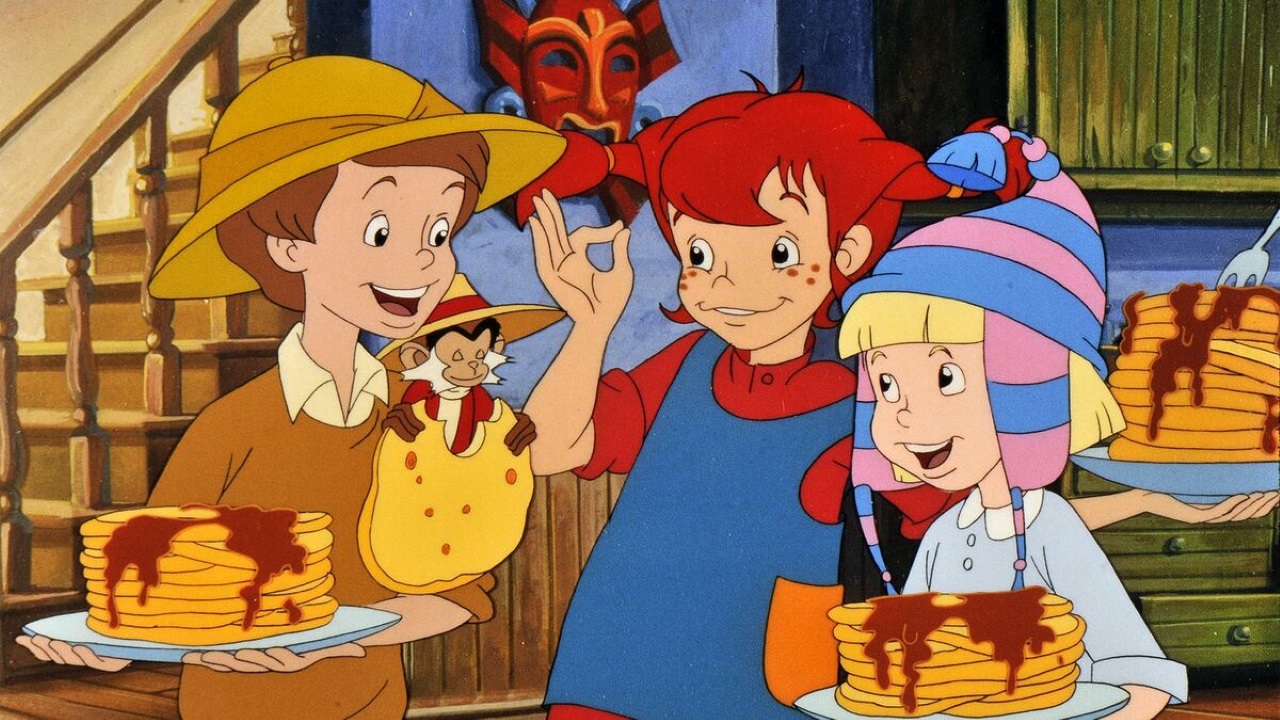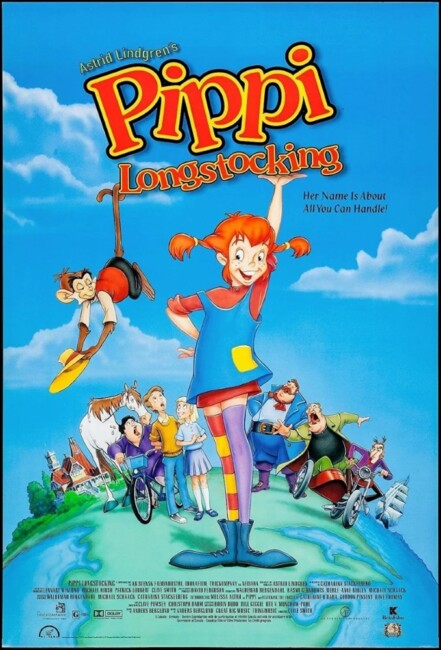Crew
Director – Clive Smith, Screenplay – Catherina Stackelberg, Based on the Pippi Longstocking Books by Astrid Lindgren, Producers – Waldemar Bergendahl, Hasmi Giakoumis, Merle-Anne Ridley & Michael Schaack, Music – Anders Berglund, Animation Supervisors – Edson Basarin, Robin Budd, Bill Giggle & Ute v. Münchow-Pohl, Art Direction – Christoph Baum & Clive Powsey. Production Company – AB Svenski Filmindustri/Iduna Film/TFC Trickcompany/Nelvana.
Voices
Melissa Altro (Pippi Longstocking), Noah Reid (Tommy Settergren), Olivia Garratt (Annika Settergren), Catherine O’Hara (Helga Prysselius), Dave Thomas (Thunder-Karlsson), Wayne Robson (Bloom), Phillip Williams (Klang/Ringmaster), Rick Jones (Kling), Gordon Pinsent (Captain Ephriam Longstocking), Carole Pope (The Teacher), Karen Bernstein (Mrs Settergren)
Plot
Captain Longstocking is washed overboard at sea during a storm but not before he promises his daughter Pippi that he will make it back to their home at Villa Villekula. Pippi settles into Villa Villekula along with her horse and monkey. She befriends the two children next door, Tommy and Annika Settergren, who are amazed and captivated by her nonsensical take on life. At the same time, Pippi is targeted by the authoritarian Mrs Prysselius who determines that she must be placed in a children’s home, as well as two escaped criminals, Thunder-Karlsson and Bloom, who want to get their hands on the supply of gold coins in the house.
Pippi Longstocking was a creation of Swedish children’s writer Astrid Lindgren (1907-2002). Lindgren began publishing the stories with Pippi Långstrump (1945), although the character quickly became better known under her English-language retitling ‘Pippi Longstocking’. Lindgren published four other Pippi Longstocking tales Pippi Goes on Board (1946), Pippi in the South Seas (1948), Pippi Goes on Holiday (1974) and Pippi’s After Christmas Party (1979), and went onto write numerous other children’s tales, but Pippi is her most enduring creation and has been seen in an extraordinary number of guises, including even a Pippi Longstocking theme park, Astrid Lindgren’s Varld, in Lindgren’s hometown of Vimmerby.
There were several film versions made of the Pippi Longstocking tales – a Swedish-made film Pippi Långstrump (1949); a dreary series of Swedish-made children’s films – Pippi Longstocking (1969), Pippi Goes on Board (1970), Pippi in the South Seas (1970) and Pippi on the Run (1973); a 1982 Russian musical adaptation; an American tv adaptation Pippi Longstocking (1985) starring Carrie Kei Heim; and a terrible American theatrical film The New Adventures of Pippi Longstocking (1988) starring Tami Erin. Of Pippi’s on-screen adventures so far, this animated film is actually the best.
This version was a Swedish-German-Canadian co-production made by Canadian animation company Nelvana. Nelvana emerged in the 1970s with various tv specials, most notably The Devil and Daniel Mouse (1978) and the animated Boba Fett segment of The Star Wars Holiday Special (1978) and then went onto animated tv series such as George Lucas’s Star Wars spinoffs Droids (1985-6) and Ewoks (1985-7), Beetlejuice (1989), Clone High (2002-3) and The Adventures of Tintin (1991-2). They also released several films, including an unsuccessful venture into adult fantasy with Rock and Rule (1983), three Care Bears movies and Babar: The Movie (1989).

With The Adventures of Tintin, Nelvana did a superb job of taking Hergé’s much loved comic-strip stories and faithfully rendering them on screen, sometimes even down to replicating the same strip panels. Nelvana lavish the same modest and unassuming effort on Astrid Lindgren’s tales here. The animation is plain, nicely rounded and extremely colourful. Animation is, one suspects, the best place for Lindgren’s absurdist tales and of all the adaptations this film is the most faithful to the spirit of the Pippi Longstocking stories.
That said, given the possibilities that animation offers, the film is surprisingly light when it comes to fantastique content – which amounts to little more than Pippi demonstrating super-strength. The latter half of the film disappointingly turns into a good deal of slapstick tomfoolery involving cops and villains running around a circus and the countryside, where the film almost seems to be trying to become an animated version of Home Alone (1990).
Throughout Pippi is seen as a force of anarchy – she is called Miss Mayhem at one point. (Indeed, when the original books came out in the 1940s, they caused a storm of controversy in Sweden, with Lindgren accused of undermining authority and promoting anarchy, and in France were even printed censored of such elements). Pippi Longstocking is a character who exists in a perpetual state of childhood playfulness and chaos where nonsense makes sense – watering flowers in the rain, unable to see the point in going to school. She is constantly offering offbeat little questionings of the status quo – “It costs money to look?” she says of a circus, “I go around looking all day – who knows how much money I have stared up already?” Up against this she is a constant thorn in the side of adults who take themselves too seriously or are greedy.
This film was followed by an animated tv series Pippi Longstocking (1998) from Nelvana, which lasted for twenty-four episodes, and a Swedish-made animated sequel Pippi’s Adventures in the South Seas (1999).

